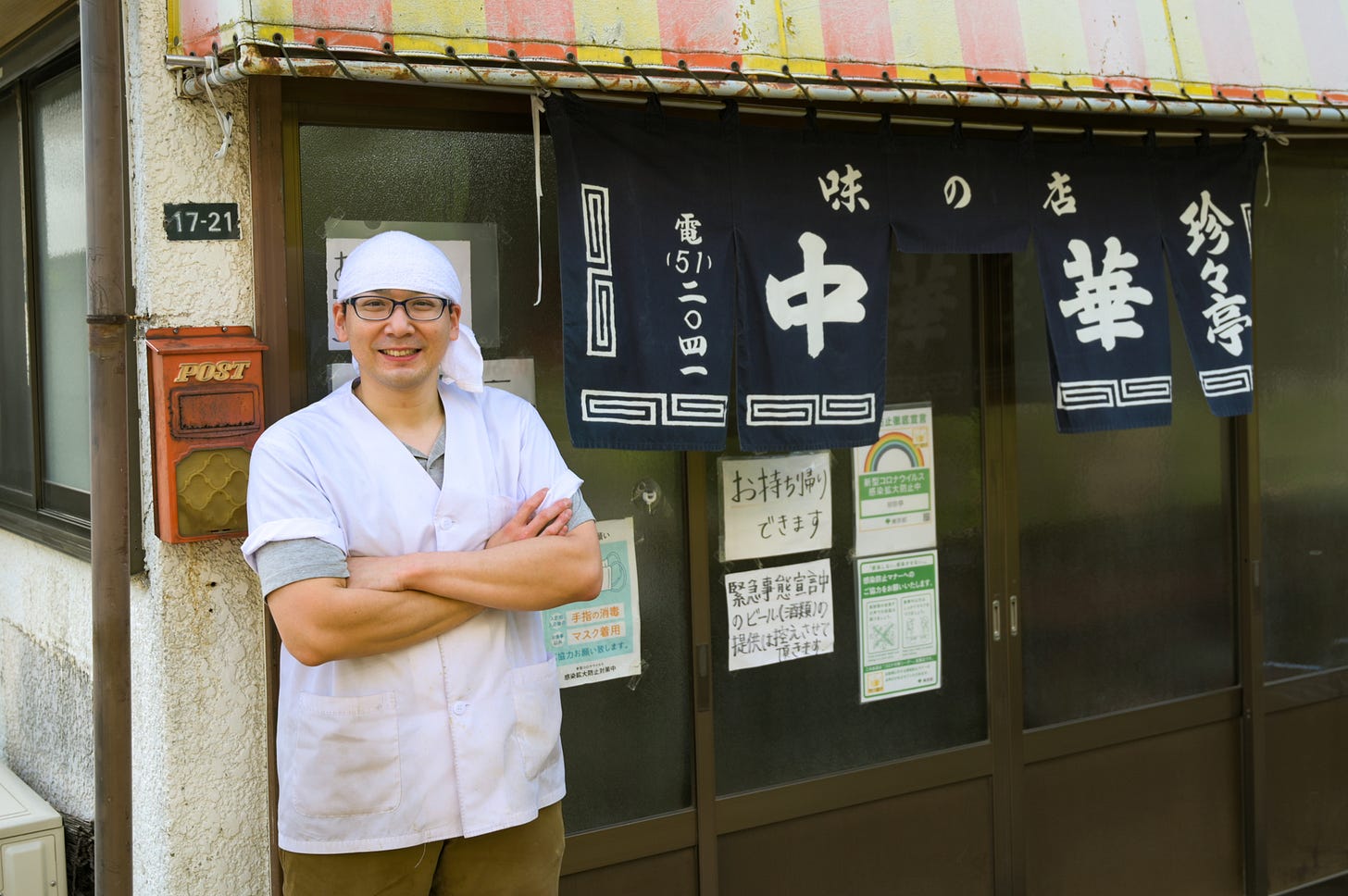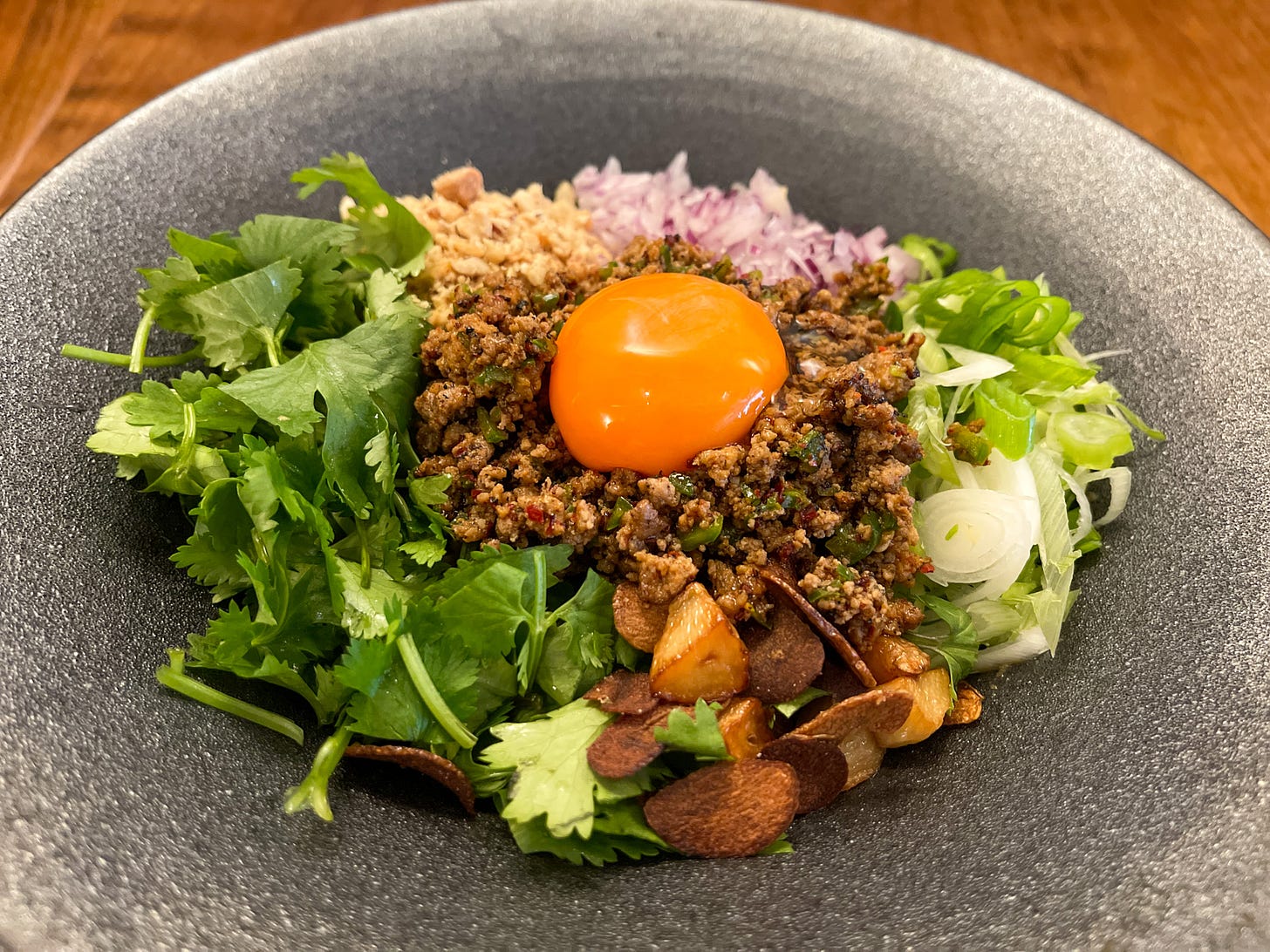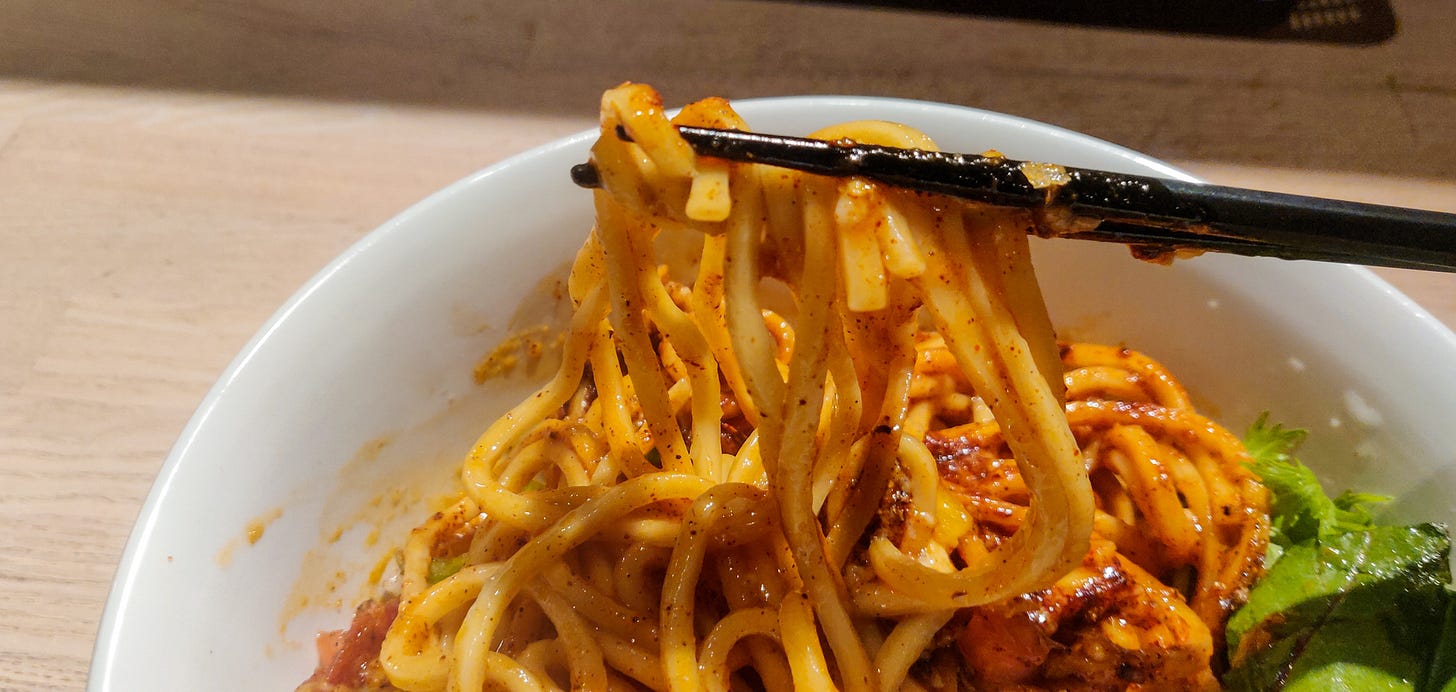As you may have noticed, the Ramen Beast team has been a bit quiet lately... We've been busy!
Abram was in California, rebooting his cross-border ramen restaurant biz, Patrick was in the Japanese mountains building a sauna structure, and Cody started selling ramen equipment and ingredients online to aspiring chefs around the world. Meanwhile, Hiroshi found out that he's going to be a father and got married (again!). Everyone's been pulled in different directions...
But, we're back.
This week is all about Abura Soba, aka Maze Soba, aka Shirunashi. A soupless ramen known by many names, this is a somewhat fuzzy category. But it’s also an increasingly exciting genre, due to the way it seems to be rapidly following the tried and true trajectory from lowly blue collar crowd-pleaser to widely adopted hotbed of culinary experimentation. First there was ramen, then there was tsukemen, and now — perhaps — there is Abura Soba? As you'll learn below, thanks both to the pandemic and recent innovations in craft noodle-making, Abura Soba, or Maze Soba, is quickly becoming the third pillar that many ambitious Japanese ramen chefs feel obliged to master and include in their repertoire.
If you’re new here, this is the Ramen Beast Newsletter — stories, history and street-level intel from Japan’s vast ramen subculture.
Here's Abram, our team’s most relentless ramen eater:
A bowl of noodles arrives in front of you. No soup?! You mix all of the ingredients well, fully coating the noodles with a slick, glistening layer of flavorful tare sauce, chili oil and fat. On appearance alone, this dish seems more suitable as a late-night snack or food fit for a college student living in the dorms. You take your first slurp, not expecting much more than a bite of yakisoba. But then it hits you — a rush of flavor, fat+carbs, bursting endorphins… like a drug, you know you should’t enjoy it this much, but it’s just so. damn. good. You eat almost guiltily, wondering if it's really worth boiling complicated soup stocks for days when ramen can be this satisfying without any of the fuss. This is the ramen phenom known as Abura Soba.
What is Abura Soba?
Within the Japanese ramen world, Abura Soba is known as the original soupless ramen with roots dating back to Western Tokyo in the 1950s. In its most traditional form, the dish comes with semi-firm, freshly cooked noodles piled deep in a bowl. Instead of soup, you find a generous puddle of tare seasoning and abura lurking beneath the bed of noodles ("abura" means oil or fat; often it’s a flavorful lard, sesame oil or some other shop trade secret). A few toppings usually come nestled in the noodles too. A soft-boiled egg, chashu, crunchy menma and narutomaki (fish cake) are the classics.
Unlike most ramen, this dish is traditionally served to you unfinished. Arrayed on the counter are bottles of vinegar and chili oil, which diners are expected to squirt into their bowl to complete the taste. Most shops have a recommended amount — for example, three-second pours of each — but you can add as much or as little as you like. Achieving a nice balance with the other ingredients is recommended, but there are always the extremists who prefer to drench their noodles in blazing red oil or mouth-puckering vinegar (or both). The next step is to use your chopsticks to thoroughly mix everything, making sure that all of the noodles get a good coating. If you’ve never tried this style and you are trying to imagine it, it's like the ramen equivalent of saucing a pasta. Taste-wise, it’s a carb lovers delight: chewy noodles, salt, fat, vinegar bite, a bit of heat, all pulled together with some soothing umami undertones. It’s no surprise that this dish first emerged as a drinking food, and much of that instinctual appeal remains. If new-school Tori Soba’s flashy technique and refinement are all about clean, forebrain sophistication, Abura Soba tends to be about satisfying the simple cravings of the foodie Id.
The Speed-Read History
Unlike some of the other ramen specialties we've profiled recently —Iekei, Jiro, or Katsuura Tantanmen — which had a singular “originator” of the style, Abura Soba has a slightly blurry origin story. According to most ramen historians, this "no broth ramen" originated in one of two restaurants in West Tokyo in the early 1950s. Interestingly, both of these historic spots are said to have invented Abura Soba spontaneously to meet customers' demands for a hearty drinking snack.
Many ramen researchers name Sankou, a small shop near Kunitachi station in the remote western suburbs of Tokyo, as the first Abura Soba joint. The shop opened its doors in the early 1950s as a humble "shina soba-ya," or Chinese noodle house, as the first wave of Japanese ramen establishments were known. This was the chaotic, culturally tumultuous post-war period of Japan, and the shop quickly became a lively drinking den as much as a restaurant. According to Sankou's current master, grandson of the original proprietor, customers who had drunk their weight in beer or sake would often request something carb-heavy to soak up the booze and close out their night. Since the hot soup in a typical bowl of ramen was less appealing to these already liquid-filled customers, Sankou's founder came up with the idea of serving an oily, salty, soupless version instead. According to some, this was the true birth of Japanese Abura Soba. Sankou close for several years, but the third-generation master is now back at the helm, serving the same simple Abura Soba recipe pioneered by his grandfather some 70 years ago. Sankou's Aburasoba comes with slightly over-boiled noodles and includes an alcoholic drink order, which is said to be how they were served back in the day. The current master is a sociable guy, happy to sit down over a beer and chat about the shop's history — which is exactly what Cody did on a recent weekday to get the info above.
Still, to most Tokyo ramen heads, Sankou is not considered to be the true Abura Soba OG. The honor instead goes to Chinchintei, a fellow West Tokyo relic that opened its doors in 1954. Again, the history is fuzzy and we couldn’t track down a definitive account of who really did it first. It’s entirely possible that the two shops simultaneously invented a very similar dish to serve the same needs of Tokyo’s fatigued and boozed-up post-war masses (Convergent Evolution).
With its tattered awning, formica counters and colorful crowd of working-class regulars, Chinchintei is one of those Tokyo shops that instantly wins you over with its nostalgic, time-worn atmosphere. The shop is currently run by third-generation master Kotani Shuichi, 36, who spent his childhood in the shop and began working there in his late teens. Kotani-san was called upon to take over the shop earlier than expected, when he was just 21 years old, after his father died suddenly in 2006. Like his father before him, he is passionate about serving the exact recipes that his grandfather invented some seven decades ago. He works with the same multi-generational local noodle factory his grandpa did, and he has maintained the old man's same trade secret tare sauce. We recently sat down with Kotani-san for a brief chat after closing time.

"We have a lot of long-time customers — some who have been eating here regularly for over 50 years — so I think it’s really important to keep providing them with the tastes they remember from the Abura Soba served by my dad and grandfather,” he told us. “Growing up, I always knew I would eventually take over and run this shop. It's my calling and I've never not been happy about that. My mother runs the cash register, and several of my siblings and relatives work here too — it's a family-run operation and always will be."
Just like Sankou, Chinchintei began as a very simple shoyu ramen shop. But during its earliest days of business, the area around the establishment — today, the pleasant suburban area of Musashisakai — was booming with urban reconstruction, and day laborers would pour in after dark to eat and drink. Listening to his customers' requests for something cheap, filling and good with drink, the elder Kotani-san turned to Chinese Lo Mein for inspiration, and used ramen noodles and ingredients to create a loose Japanese approximation. Today, Chinchintei still has a shoyu ramen on the menu, but the vast majority of customers come for the shop’s original Abura Soba.

Kotani-san's tip: "Since Aburasoba doesn’t have soup, the noodles tend to go cold fast. The trick is to thoroughly mix the noodles with the seasoning sauce and eat quickly while it’s still nice and warm. First try a bite as it is, then add some of the seasonings provided at the table to adjust the flavors to your individual liking."
For food fans interested in ramen lore and history, Chinchintei remains a must-visit.
Rise in Popularity
Following the explosive popularity of Chinchintei, several other Chinese restaurants and simple Shoyu Ramen shops in West Tokyo adopted the dish and put it to their own purposes throughout the 1970s, often with slight tweaks in approach. In 1971, Hoka in nearby Higashi Koganei began serving what they dubbed "Takara Soba," a rendition on Abura Soba that includes a bit of chicken stock mixed into the tare for added depth of flavor. Next up was Chinraitei in Kichijoji, which kept to the drinking culture roots of the dish, but added a bit more soup, creating an easy-to-slurp ramen/abura soba hybrid. Kichijoji was a counterculture hotbed in that time, famous for its all-night jazz bars and teeming manga artist community. Chinraitei, which remains in operation today, was nestled right in the heart of it, hidden on a back alley within Harmonica Yokocho, the city's famous warren of drinking dens. Chinraitei's version was a hit with the salarymen, students and disreputables of the after-hours crowd, further propelling citywide awareness of the dish.
As Abura Soba began to evolve and spread from the West Tokyo shops that invented it, countless methods for making soupless ramen emerged throughout the Japanese capital — and eventually across the country as a whole. Ironically, it can be argued that the shop that made the style truly prolific was a chain, one that specializes in Abura Soba only. Now with close to 40 shops in Japan and a few overseas, the official name is "Tokyo Abura Gumisō Honten," but most people recognize it by the large sign hanging in front of each branch, which reads, simply, "Abura Soba" (油そば). Located all over central Tokyo, the brand undoubtedly played a role in popularizing the style among the masses. Tokyo Abura Gumisō Honten’s take on Abura Soba is a straight-forward imitation of the original Chinchintei version. It’s perhaps lacking some of the subtlety and homeyness of the OG, but their shops are accessible everywhere and the noodle/oil/vinegar/chili combo remains irresistibly easy to enjoy, chain or not.
During the ramen boom of the 1990s, some shops began referring to more innovative versions of Abura Soba as Maze Soba, which literally means "mixing noodles" in Japanese. Others subtracted the soup stock from whatever their house specialty ramen dish was, and labeled the soup-less version "Shirunashi" (Japanese for "without soup").
The names Abura Soba, Shirunashi and Maze Soba are essentially interchangeable these days (although Abura Soba is generally used for more traditional versions), and there are countless varieties and methods by which the style can be done. Some ramen shops overseas have begun offering attempts at Maze Soba, dubbing it “Dry Ramen” (easy to understand, but a bit of a misnomer, given that no decent Maze Soba is actually dry).

Abura Soba boom?
In the same way that practically any version of Ramen can be adapted into Tsukemen, almost any ramen dish can also be made without the soup into Maze Soba/Shirunashi/Abura Soba. In the past, many top-level chefs seem to have thought there was little reason to bother. But recent developments have shined a spotlight on the category.
Explains Tomoharu Shono, the ramen creator behind the Mensho brand, whose empire includes Maze Soba specialty house Jikaseimen Gachi among its dozen-plus Tokyo shops:
Previously, Abura Soba was seen as somewhat unappealing by many ramen masters because of how simple it is. Without a soup, there was little to specialize in and put creative effort into. How could you shine? But recently, an increasingly number of ramen shops have started making fresh noodles in-house instead of ordering them from noodle factories. Now, masters are finding that Maze Soba is a perfect way to showcase the dedication and craft behind their hand-made noodles.
Abura Soba really is all about how to deliciously serve noodles. Of course, adding in toppings can make the dish more enjoyable, but bringing out the flavors and texture of the noodles and balancing it with the fat and seasoning is the core of great Abura Soba.

Pandemic Accelerator
Due to the factors mentioned by Shono-san, Abura Soba was already well on its way to ramen master respectability — but as in so many other areas, the pandemic has accelerated the trend. During the hardest phases of Japan’s domestic COVID-19 outbreak, many ramen shops, both chains and master-run specialty shops, have turned to the once unthinkable option of selling takeaway food as a way to survive government requests for indoor dining shutdowns. Prior to 2020, takeaway ramen was virtually non-existent in Tokyo, aside from the old school Chinese restaurant practice of demae (delivery) ramen — cheap Chinese food delivered to offices and homes via bicycle. Ramen masters universally believe their bowls should be consumed the moment they are handed across the counter to the customer — any delay diminishes flavor, softens noodles to mush and destroys the delicate integrity of their creation.
In light of such realities, Abura Soba became a godsend for ramen chefs who were struggling to survive shutdown but determined to maintain the quality of whatever they served. In the absence of piping hot soup, Abura Soba is a far heartier delivery dish than traditional ramen. One container holds the noodles, another the oil and tare — and the at-home eater need only dump, mix and slurp. Of course, it's not quite as fresh and flawless as it would be in the shop — we’ve met no ramen master who particularly likes making food for delivery — but it's miles better than the sloshed, overcooked concoction you would get with a bowl of ramen that arrives via the back of a Tokyo motorbike.
It’s possible the pandemic has even tipped Abura Soba into a culinary virtuous cycle, Shono-san says:
"During the pandemic, takeaway ramen has become a focus, so we've seen even more shops try out Abura Soba and experiment with what they can do with it. Having more good Abura Soba options has increased its popularity with customers too. As customer demand increases, even more masters will be encouraged to dedicate themselves to perfecting it. We are bound to see Abura Soba evolve in even more exciting ways in the near future."
Zuru Zuru x Ramen Beast Bowl (Tokyo Version)
RB's ongoing collaboration with Kyushu ramen culture guru Johnny has taken the next step with the release of a limited edition, Japan-made ramen bowl. Click here for more.











Aburasoba, Taiwan mazesoba, Junk-style mazesoba, shirunashi tantanmen, I love them all.
They haven't replaced ramen completely in my ramen-eating repertoire but I pretty much never eat tsukemen anymore, I probably haven't had more than a handful of bowls over the past five or six years since I started eating the soupless stuff regularly. I wonder if that is true for any other people.